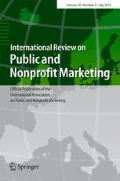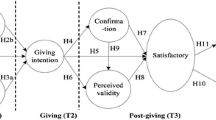Abstract
Samples of lapsed and non-lapsed regular standing order donors to a large UK healthcare charity completed a questionnaire designed to establish possible reasons for lapse or continuation and, for the sample of lapsers, the main factors that contributed to whether a lapse was due to a person’s inability to pay. All the donors had been recruited face to face by employees of a professional external fundraising agency. A model was constructed hypothesising that lapse decisions, and the importance of financial considerations in such decisions, depended in part on an individual’s susceptibility to influence by an agency employee, the perceived importance of the charity’s cause, the person’s level of public commitment to the cause, level of income and recent changes in income, age, and general tendency to overspend.

Similar content being viewed by others
References
Agrawal N, Maheswaran D (2005) The effects of self-construal and commitment on persuasion. J Consum Res 31:841–849
Ahluwalia R (2000) Examination of psychological processes underlying resistance to persuasion. J Consum Res 27:217–232
Armstrong A, Overton T (1977) Estimating nonresponse bias in mail surveys. J Mark Res 14:393–402
Bassili JN (1996) Meta-judgmental versus operative indexes of psychological attributes: the case of measures of attitude strength. J Personal Soc Psychol 71:637–653
Bearden W, Haws K (2011) How low spending control harms consumers. J Acad Mark. Sci. Early view website. Accessed 1 December 2011
Bearden W, Netmeyer R, Teel J (1989) Measurement of consumer susceptibility to interpersonal influence. J Consum Res 15:473–481
Bennett R (2006) Predicting the lifetime durations of donors to charities. J Nonprofit Public Sect Mark 15:45–67
Bennett R (2009) Regret and satisfaction as determinants of lapsed donor recommencement decisions. J Nonprofit Public Sect Mark 21:347–366
Bennett R (2012) Factors influencing time to break even of agency recruited low value charity donors. Volunt Int J Volunt Nonprofit Org in press
Boninger DS, Lrosnick JA, Berent MK, Fabrigar IR (1995) The cases and consequences of attitude importance. In: Petty C, Krosnick JA (eds) Attitude strength: antecedents and consequences. Erlbaum, Hillsdale, pp 159–189
Burnett K (2011) Coming soon to a Mall near you: New fundraising technique taking hold, Contributions Magazine, June 2011, pp. 1–2. www.contributionsmagazine.com Accessed on 29 June 2012
Burnett K (2012) Facing up to face to face. Fundraising Success Magazine, June 2012, pp. 1-2. www.fundraisingsuccessmag.com. Accessed on 26 June 2012
Cahalane C (2012) Street fundraising plays a vital role in getting charities the funds they need. Guardian Professional, 28 September 2012, p.1, www.guardian.co.uk/voluntary-sector-network. Accessed on 2 October 2012
Cialdini RB, Goldstein NJ (2004) Social influence: compliance and conformity. Annu Rev Psychol 55:591–621
Cross SE, Bacon PL, Morrris ML (2000) The relational-interdependent self-construal and relationships. J Personal Soc Psychol 78:791–808
Deutsch M, Gerard HB (1955) A study of normative informative social influences upon individual judgement. J Abnorm Soc Psychol 51:629–636
Fleming M, Tappin R (2009) Face to face cancellation rates: establishing a benchmark. Int J Nonprofit Volunt Sect Mark 14:341–352
PFRA (Professional Fundraising Regulatory Association) (2011) Face to face fundraising. London PFRA. www.pfra.org.uk. Accessed 24 August 2011
Goldberg L (1990) An attentive description of personality: the big-five structure. J Personal Soc Psychol 59:1216–1229
Gopinath M, Nyer P (2009) The effect of public commitment on resistance to persuasion: the influence of attitude certainty, issue importance, susceptibility to normative influence, preference for consistency and source proximity. Int J Res Mark 26:60–68
Harris J (2012) The chugging backlash warrants few tears. The Guardian, 6 March 2012, p.1. www.guardian.co.uk. Accessed on 2 October 2012
Hoch S, Loewenstein G (1991) Time inconsistent preferences and consumer self-control. J Consum Res 17:492–506
Holt LE (1970) Resistance to persuasion to explicit beliefs as a function of commitments and desirability of logically-related beliefs. J Personal Soc Psychol 16:583–591
Jay E (2001) The rise and fall? – of face to face fundraising in the United Kingdom. New Dir Philanthr Fundrais 33:83–94
Jones M (2010) Charity donors ‘pay fundraisers’. BBC News, 26 August 2010. http://news.bbc.co.uk. Accessed 25 August 2011.
Kempen L (2007) Status consumption and ethnicity in Bolivia: evidence from durables ownership. Int J Consum Stud 31:76–89
Lake H (2012) Record number of donors recruited face to face fundraising in 2011/2012, Fundraising Magazine, June 2012, p.1.www.fundraising.co.uk. Accessed on 2 July 2012
Lo J, Harvey N (2011) Shopping without pain: compulsive buying and the effects of credit card availability in Europe and the Far East. J Econ Psychol 32:79–92
Mangleburg T, Doney P, Bristol T (2004) Shopping with friends and teens’ susceptibility to peer influence. J Retail 80:101–116
McGuire W (1968) Personality and susceptibility to social influence. In: Borgatta EF, Lambert WW (eds) Handbook of personality theory and research. Rand McNally, Skokie, IL, pp 1130–1187
Pomerantz EM, Chaiken S, Tordesillas RS (1995) Attitude strength and resistance process. J Personal Soc Psychol 69:408–419
Quigley R (2010) Revealed: how fees for high street ‘chuggers’ are eating up the millions you donate to charity. Mail Online, 27 August 2010. www.dailymail.co.uk. Accessed on 25 August 2011
Sargeant A, Hudson J (2008) Donor retention: an exploratory study of door to door recruits. Int J Nonprofit Volunt Sect Mark 13:89–101
Sargeant A, Jay E (2004) Reasons for lapse: the case of face to face donors. Int J Nonprofit Volunt Sect Mark 9:171–182
Sargeant A, Jay E (2010) Fundraising management: analysis, planning and practice. Routledge, New York
Sargeant A, Woodliffe L (2007) Gift giving: an interdisciplinary review. Int J Nonprofit Volunt Sect Mark 12:275–307
Soman D (2001) Effects of payment mechanism on spending behaviour: the role of rehearsal and immediacy of payments. J Consum Res 27:460–474
Sun T, Tai Z, Tsai K (2009) The role of interdependent self-construal in consumers’ susceptibility to retail salespersons’ influence: a hierarchical approach. J Retail Consum Serv 16:360–366
Tangney J, Baumeister R, Boone A (2004) High self-control predicts good adjustment, less pathology, better grades, and interpersonal success. J Personal 72:271–322
Upsall D (2012) Fundraising success: the dynamic growth in Continental Europe, Fundraising Success Magazine, June 2012, pp.1–3. www.fundraisingsuccessmag.com. Accessed on 26 June 2012
Wentzel D, Brett M, Torsten T, Heikel S (2007) The impact of susceptibility to informational influence on the effectiveness of consumer testimonials. Proceedings of the 36th European Marketing Academy Conference, Reykjavik University, Reykjavik
Wooten D, Reed A (1998) Informational influence and the ambiguity of product experience: order effects on the weighting of evidence. J Consum Psychol 7:79–99
Author information
Authors and Affiliations
Corresponding author
Rights and permissions
About this article
Cite this article
Bennett, R. Factors influencing the probability of early lapse of face to face recruited charity donors. Int Rev Public Nonprofit Mark 10, 129–142 (2013). https://doi.org/10.1007/s12208-012-0092-2
Received:
Accepted:
Published:
Issue Date:
DOI: https://doi.org/10.1007/s12208-012-0092-2




